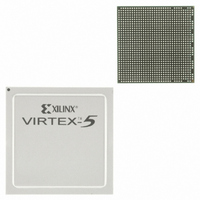XC5VLX110-1FFG1760C Xilinx Inc, XC5VLX110-1FFG1760C Datasheet - Page 327

XC5VLX110-1FFG1760C
Manufacturer Part Number
XC5VLX110-1FFG1760C
Description
IC FPGA VIRTEX-5 110K 1760FBGA
Manufacturer
Xilinx Inc
Series
Virtex™-5 LXr
Datasheets
1.XC5VLX30-1FFG324C.pdf
(91 pages)
2.XC5VLX30-1FFG324C.pdf
(13 pages)
3.XC5VLX30-1FFG324C.pdf
(385 pages)
Specifications of XC5VLX110-1FFG1760C
Number Of Logic Elements/cells
110592
Number Of Labs/clbs
8640
Total Ram Bits
4718592
Number Of I /o
800
Voltage - Supply
0.95 V ~ 1.05 V
Mounting Type
Surface Mount
Operating Temperature
0°C ~ 85°C
Package / Case
1760-BBGA, FCBGA
For Use With
HW-V5-ML523-UNI-G - EVALUATION PLATFORM VIRTEX-5HW-AFX-FF1760-500-G - BOARD DEV VIRTEX 5 FF1760
Lead Free Status / RoHS Status
Lead free / RoHS Compliant
Number Of Gates
-
Available stocks
Company
Part Number
Manufacturer
Quantity
Price
Company:
Part Number:
XC5VLX110-1FFG1760C
Manufacturer:
XilinxInc
Quantity:
3 000
Company:
Part Number:
XC5VLX110-1FFG1760C
Manufacturer:
Xilinx Inc
Quantity:
10 000
Company:
Part Number:
XC5VLX110-1FFG1760CES
Manufacturer:
Xilinx Inc
Quantity:
10 000
- XC5VLX30-1FFG324C PDF datasheet
- XC5VLX30-1FFG324C PDF datasheet #2
- XC5VLX30-1FFG324C PDF datasheet #3
- Current page: 327 of 385
- Download datasheet (14Mb)
Virtex-5 FPGA User Guide
UG190 (v5.3) May 17, 2010
IODELAY Ports
Table 7-7: IODELAY Primitive Ports (Continued)
Data Input from the IOB - IDATAIN
The IDATAIN input is driven by its associated IOB. In IDELAY mode the data can be
driven to either an ILOGIC/ISERDES block, directly into the FPGA fabric, or to both
through the DATAOUT port with a delay set by the IDELAY_VALUE.
Data Input from the FPGA Fabric - ODATAIN
The ODATAIN input is driven by OLOGIC/OSERDES. In ODELAY mode, the ODATAIN
drives the DATAOUT port which is connected to an IOB with a delay set by the
ODELAY_VALUE.
Data Input for IODELAY from the FPGA Fabric - DATAIN
The DATAIN input is directly driven by the FPGA fabric providing a fabric logic accessible
delay line. The data is driven back into the fabric through the DATAOUT port with a delay
set by the IDELAY_VALUE. DATAIN can be locally inverted. The data cannot be driven to
an IOB.
Data Output - DATAOUT
Delayed data from the three data input ports. DATAOUT connects to the fabric (IDELAY
mode), or an IOB (ODELAY mode) or both (bidirectional delay mode). If used in the
bidirectional delay mode, the T port dynamically switches between the IDATAIN and
ODATAIN paths providing an alternating input/output delay based on the direction
indicated by the 3-state signal T from the OLOGIC block.
3-state Input - T
This is the 3-state input control port. For bidirectional operation, the T pin signal also
controls the T pin of the OBUFT.
Clock Input - C
All control inputs to IODELAY primitive (RST, CE, and INC) are synchronous to the clock
input (C). A clock must be connected to this port when IODELAY is configured in variable
mode. C can be locally inverted, and must be supplied by a global or regional clock buffer.
This clock should be connected to the same clock in the SelectIO logic resources (when
using ISERDES and OSERDES, C is connected to CLKDIV).
DATAIN
Name
Port
INC
RST
CE
C
T
Direction
Input
Input
Input
Input
Input
Input
www.xilinx.com
Data input for IODELAY from the FPGA fabric
3-state input control port. This port determines dynamically
if IODELAY is used as IDELAY or ODELAY.
Enable increment/decrement function
Increment/decrement number of tap delays
Reset the IODELAY element to the pre-programmed value
Clock input used in variable mode
Input/Output Delay Element (IODELAY)
Function
327
Related parts for XC5VLX110-1FFG1760C
Image
Part Number
Description
Manufacturer
Datasheet
Request
R

Part Number:
Description:
IC FPGA VIRTEX-5 110K 676FBGA
Manufacturer:
Xilinx Inc
Datasheet:

Part Number:
Description:
IC FPGA VIRTEX-5 110K 1153FBGA
Manufacturer:
Xilinx Inc
Datasheet:

Part Number:
Description:
FPGA Virtex®-5 Family 110592 Cells 65nm (CMOS) Technology 1V 676-Pin FCBGA
Manufacturer:
Xilinx Inc
Datasheet:

Part Number:
Description:
IC FPGA VIRTEX-5 110K 676FBGA
Manufacturer:
Xilinx Inc
Datasheet:

Part Number:
Description:
IC FPGA VIRTEX-5 110K 1153FBGA
Manufacturer:
Xilinx Inc
Datasheet:

Part Number:
Description:
IC FPGA VIRTEX-5 110K 1760FBGA
Manufacturer:
Xilinx Inc
Datasheet:

Part Number:
Description:
IC FPGA VIRTEX-5 110K 1153FBGA
Manufacturer:
Xilinx Inc
Datasheet:

Part Number:
Description:
IC FPGA VIRTEX-5 110K 1760FBGA
Manufacturer:
Xilinx Inc
Datasheet:

Part Number:
Description:
IC FPGA VIRTEX-5 110K 1153FBGA
Manufacturer:
Xilinx Inc
Datasheet:

Part Number:
Description:
IC FPGA VIRTEX-5 110K 1760FBGA
Manufacturer:
Xilinx Inc
Datasheet:

Part Number:
Description:
IC FPGA VIRTEX-5 110K 676FBGA
Manufacturer:
Xilinx Inc
Datasheet:

Part Number:
Description:
IC FPGA VIRTEX-5 110K 1153FBGA
Manufacturer:
Xilinx Inc
Datasheet:

Part Number:
Description:
IC FPGA VIRTEX-5 110K 676FBGA
Manufacturer:
Xilinx Inc
Datasheet:

Part Number:
Description:
IC FPGA VIRTEX-5 110K 676FBGA
Manufacturer:
Xilinx Inc
Datasheet:

Part Number:
Description:
IC FPGA VIRTEX-5 110K 1153FBGA
Manufacturer:
Xilinx Inc
Datasheet:











